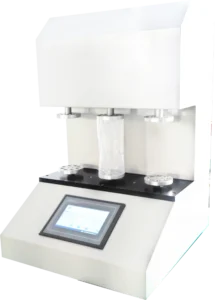The Gelbo Flex tester is an essential instrument for evaluating the flex durability of flexible barrier materials, such as packaging films and laminates. By simulating the repetitive twisting and compression these materials endure during handling and transportation, the Gelbo Flex Tester assesses their resistance to flex-induced failures, including the formation of pinholes and degradation of barrier properties. This evaluation is crucial for industries like food, medical, pharmaceutical, and electronics, where maintaining package integrity is vital.
Understanding the Gelbo Flex Tester
The tester operates by subjecting a material sample to a combination of twisting and horizontal compression motions. According to ASTM F392, the standard practice for conditioning flexible barrier materials for flex durability, the tester performs a twisting motion of 440 degrees in the first 90 mm of the stroke, followed by a straight horizontal motion of 65 mm, at a frequency of 45 cycles per minute. This rigorous testing process effectively simulates the mechanical stresses materials face during real-world usage.
Crumple Flex Tester and Its Relation to ASTM F392
While the Gelbo Flex Tester focuses on combined twisting and compression actions, the Crumple Flex Tester evaluates a material’s resistance to damage from crumpling and flexing, particularly for coated fabrics. Although both testers assess flex durability, they differ in their specific applications and testing methods. ASTM F392 primarily pertains to the Gelbo Flex testing method, emphasizing the importance of selecting the appropriate test based on material type and intended application.
Importance of ASTM F392 Compliance
Adhering to ASTM F392 ensures a standardized approach to evaluating the flex durability of flexible barrier materials. This compliance is vital for manufacturers aiming to maintain consistent quality and reliability in their packaging solutions. The standard outlines various conditioning levels:
-
Condition A: Full flex for 1 hour (2,700 cycles)
-
Condition B: Full flex for 20 minutes (900 cycles)
-
Condition C: Full flex for 6 minutes (270 cycles)
-
Condition D: Full flex for 20 cycles
-
Condition E: Partial flex for 20 cycles
These conditioning levels allow for tailored testing based on the material’s intended use and required durability.
Best Gelbo Flex Tester from Gelbotest.com
Main Parameter – Gelbo Flex Tester
Technical Feature – Gelbo Flex Tester
Applications Across Industries
The tester is indispensable in sectors where packaging integrity is paramount:
-
Food and Beverage: Ensures packaging can withstand mechanical stresses during distribution, preserving product freshness and safety.
-
Medical and Pharmaceutical: Maintains sterility and prevents contamination by verifying the durability of packaging materials under stress.
-
Electronics: Protects sensitive components by ensuring packaging materials resist flex-induced failures.
By employing the Gelbo Flex Tester, manufacturers can identify potential weaknesses in packaging materials, leading to improvements that enhance product protection and reduce the risk of failure during transportation and handling.
Incorporating the Gelbo Flex Tester into quality control processes is crucial for assessing the flex durability of flexible barrier materials. Compliance with ASTM F392 provides a standardized framework for testing, ensuring materials meet the rigorous demands of various industries. For companies like Cell Instruments, specializing in materials testing instruments, offering tester reinforces a commitment to delivering reliable solutions that uphold packaging integrity across multiple sectors.

